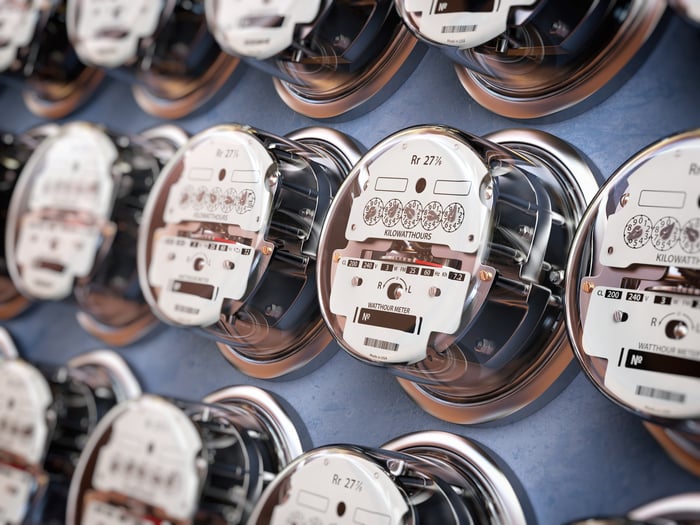In the business world, tomorrow isn't guaranteed. Once the king of all retailers, Sears Holdings filed for bankruptcy protection in 2018 and has narrowly avoided liquidation in early 2019. In 2002, WorldCom, the second-largest telecom provider in the U.S. at the time, filed for bankruptcy protection amid one of the largest accounting scandals of our time. No business is beyond challenges or the possibility of going belly-up one day.
This past week, on Tuesday, Jan. 29, California gas and electric utility PG&E (PCG 0.61%) became the latest brand-name company to declare bankruptcy and join this dubious list. Of course, PG&E's bankruptcy, which was coerced by its potential liabilities tied to the Camp Fire in 2018 and more than a dozen other Northern California fires in 2017, will be anything but straightforward. The proceedings, ultimate resolution, and presumed reemergence from bankruptcy could take years, with the costs to the company, its consumers, and ancillary industries being almost mind-numbing.
With the bankruptcy process just kicking off, here are 10 of the most outrageous figures you should know:

Image source: Getty Images.
1. $51.69 billion in liabilities
To start with, PG&E is facing nearly $52 billion in liabilities, according to its Chapter 11 bankruptcy filing. The company currently has more than $18 billion in debt on its balance sheet, but is contending with over $30 billion in possible liabilities tied to the Camp Fire and other Northern California fires in 2017. The company was recently found to not be liable for the Tubbs Fire in 2017, but this was merely a few baby steps forward in what'll likely be a marathon.
2. $71.39 billion in assets
On the other end of the spectrum, PG&E listed over $71 billion in assets during its bankruptcy filing. Why file for bankruptcy when it has almost $20 billion more in assets than liabilities? It's a good question, and it likely relates to the uncertainty of the final costs it'll bear from its responsibility in these numerous fires. What it does signify is that the business has value, and that a sale of its gas business to raise capital is a very real possibility.
3. Up to $150 billion in costs to regain compliance
According to U.S. District Judge William Alsup, who is tasked with ensuring that PG&E meets the conditions of its probation following a 2010 gas pipeline explosion, PG&E was to inspect its power grid and remove or trim trees that could potentially fall onto power lines and cause a fire. But based on a filing in U.S. District Court in San Francisco during the second week of January, per Reuters, doing so would cost PG&E up to $150 billion, and is simply not economically feasible. The utility estimates that in order to accomplish this task, it would have to pass along a 400% rate hike to its 16 million customers.
Check out the latest PG&E earnings call transcript.

Image source: Getty Images.
4. More than $29 billion in lost market cap
PG&E's woes also come at the expense of investors. Traditionally, utilities are about as safe a business model as they come. Electric utilities are often regulated by state energy commissions, which leads to predictable cash flow and dividend yields that regularly top the average payout of an S&P 500 stock. But PG&E wasn't cut from the same mold as many of its peers. Rather, after hitting a nearly $36 billion market cap in the months before the fires began in 2017, PG&E's stock has since shed more than $29 billion in market value.
5. Up to $3.7 billion lost by its three top stockholders
PG&E's fall from grace hit some of the biggest investment funds pretty hard, too. Blackrock, Vanguard Group, and State Street owned a respective $2.23 billion, $1.75 billion, and $1.13 billion in PG&E's stock at the end of the third quarter (Sept. 30, 2018), according to 13F filings with the Securities and Exchange Commission. Shares of the company have tumbled by 72% since then, through this past weekend. If these institutional giants failed to sell, they would have lost a combined $3.7 billion in just a few months.
6. 1.93 million unsuspecting investors
The California Public Employees' Retirement System (CalPERS) had 1.93 million members as of fiscal year 2016-2017. This included more than 600,000 state members, almost 600,000 public agency members, and over 700,000 school members. CalPERS currently has more than $350 billion in assets under management, but as of Oct. 31, 2018, it also owned $74.1 million in PG&E stock. That'll wind up being a sizable loss for CalPERS and its 1.93 million unsuspecting members.

Image source: Getty Images.
7. $130 million in proposed bonuses for 2018
Despite filing for bankruptcy, Bloomberg reports that PG&E is seeking approval to pay out $130 million -- yes, $130 million -- in bonuses to about 14,000 employees who met performance targets or individual goals. PG&E views this short-term cash incentive, which ranges between $5,000 and $90,000 per person (not including senior officers and directors) as vital to retaining talent and keeping employees motivated during the bankruptcy proceedings.
8. A $2.5 million severance package for its former CEO
Oh, yeah, did I fail to mention that Geisha Williams, the former CEO of PG&E who was at the helm during the 2017 and 2018 wildfires, resigned last month and was awarded a $2.5 million severance package? PG&E's officer severance package typically provides one year of salary and a short-term incentive-plan bonus. Despite being CEO for less than two years and seeing $29 billion in market cap vanish, Williams walks away $2.5 million richer.
9. $2.2 billion in renewable energy contracts in limbo
PG&E's bankruptcy also means potentially bad news for renewable energy companies like NextEra Energy (NEE 0.34%) that are involved in solar and wind production. Since the State of California required PG&E to utilize a certain percentage of renewable energy as part of its push toward cleaner energy, PG&E often negotiated purchasing contracts at above-market rates. This is the case with NextEra Energy, one of the biggest firms selling renewable electricity to PG&E. The bankruptcy filing may allow PG&E to renegotiate these contracts, sticking NextEra and its renewable peers with much lower payouts.

Image source: Getty Images.
10. Up to $1,400 an hour in lawyer fees
Finally, what you've probably been hearing is true: Lawyers involved in this case are about to make a legitimate killing. The Wall Street Journal reports that the law firm handling the utility's bankruptcy case in 2001 (PG&E the holding company didn't go bankrupt in 2001, but its utility did file for bankruptcy) charged up to $635 an hour. Today, that same firm can run up to $1,400 an hour. Considering that this bankruptcy could last years, we're likely talking about hundreds of millions of dollars in aggregate legal fees by the time this is over.
I've said it before, and it's worth repeating: What a mess!




